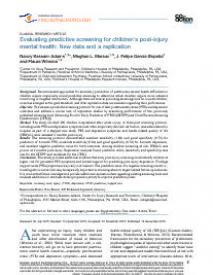Evaluating predictive screening for children’s post-injury mental health: New data and a replication
Background: Recommended approaches for secondary prevention of posttrauma mental health difficulties in children require empirically sound predictive screening to determine which children require more intensive monitoring or targeted intervention. Although there are several promising screening tools for injured children, none has emerged as the gold standard, and little replication data are available regarding their performance.
Objective: To evaluate a predictive screening protocol for risk of later posttraumatic stress (PTS) and depression outcomes and address a crucial lack of replication studies by examining performance of two previously published screening tools (Screening Tool for Early Predictors of PTSD [STEPP] and Child Trauma Screening Questionnaire [CTSQ]).
Method: The study enrolled 290 children hospitalized after acute injury. A three-part screening protocol, including acute PTS and depression symptoms and other empirically derived risk factors, was administered in hospital as part of a stepped care study. PTS and depression symptoms and health-related quality of life (HRQoL) were assessed 6 months post-injury.
Results: The screening protocol demonstrated excellent sensitivity (1.00) and good specificity (0.73) for prediction of 6-month PTS, moderate sensitivity (0.64) and good specificity (0.74) for 6-month depression, and excellent negative predictive value for both outcomes. Among children screening at risk, HRQoL was poorer at 6 months post-injury. Replication analyses found predictive utility (sensitivity and specificity) was low for the STEPP and moderate for the CTSQ.
Conclusions: This study provides additional evidence that early post-injury screening could identify children at higher risk for persistent PTS symptoms and limited support for predicting post-injury depression. Findings support acute PTS symptoms as key early risk markers. The predictive value of a negative screening result (i.e., knowing who is not at risk) may be especially important in choosing where to target limited follow-up resources. It is crucial that future investigations provide additional replication data regarding existing screening tools and evaluate additional or alternate items (proposed a priori) to improve predictive power.
Geachte bezoeker,
De informatie die u nu opvraagt, kan door psychotraumanet niet aan u worden getoond. Dit kan verschillende redenen hebben,
waarvan (bescherming van het) auteursrecht de meeste voorkomende is. Wanneer het mogelijk is om u door te verwijzen naar de bron
van deze informatie, dan ziet u hier onder een link naar die plek.
Als er geen link staat, kunt u contact opnemen met de bibliotheek,
die u verder op weg kan helpen.
Met vriendelijke groet,
Het psychotraumanet-team.
Reference:
Nancy Kassam-Adams, Meghan L. Marsac, J. Felipe García-España, & Flaura Winston | 2015
In: European journal of psychotraumatology, ISSN 2000-8066 | 6 | 29313
http://www.ejpt.net/index.php/ejpt/article/view/29313
In: European journal of psychotraumatology, ISSN 2000-8066 | 6 | 29313
http://www.ejpt.net/index.php/ejpt/article/view/29313


